Plumerias are so exotic and beautiful that it seems like they would be difficult to care for. But they’re actually quite easy to grow once you learn how.
In this post, I’ll tell you all you need to know about how to grow plumerias, including water, soil, fertilizer, and light, as well as tips one propagating, pruning, flowering, and more.
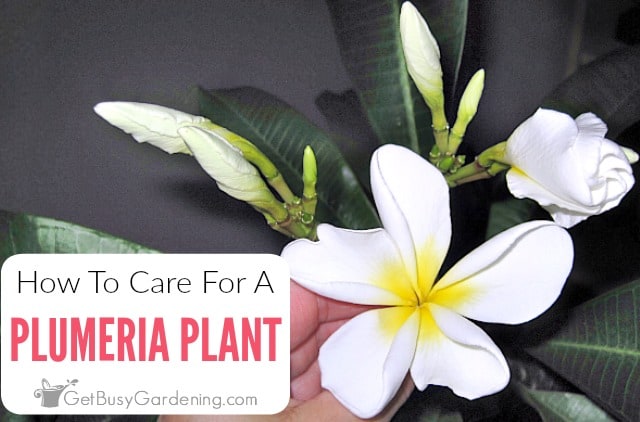
When I think back to my trips to Hawaii, one thing that I remember the most was all of the gorgeous plumerias growing and blooming everywhere.
So of course, I absolutely had to bring one home with me when I went back to Minnesota.
My new baby Hawaiian lai plant was only about a foot tall when I got it, and it bloomed shortly after I brought it home.
I instantly feel in love, and was pleasantly surprised by how low maintenance it was. If you want to try one for yourself, then you’re in the right place.
Below I’ll tell you everything you need to know about their care, and show you how to grow plumeria no matter where you live.
Plumeria Quick Care Overview
| Scientific name: | Plumeria |
| Classification: | Tropical plant |
| Common names: | Frangipani, Hawaiian Lei Plant, Kalachuchi, Champa Flower |
| Hardiness: | Zones 10+ |
| Temperature: | 60-75°F |
| Flowers: | Colors and bloom times vary by species |
| Light: | Full to partial shade, bright light indoors |
| Water: | Allow soil to dry slightly, do not overwater |
| Humidity: | Moderate to low |
| Fertilizer: | Flowering plant food in spring and summer |
| Soil: | Fast-draining, fertile soil |
| Common pests: | Spider mites, whiteflies |
Information About Plumerias
Plumerias are popular tropical plants that can grow into huge trees in their native environment.
You might know them better as a Hawaiian Lei Plant (plumerias are the type of flowers traditionally used to make leis), or maybe by their less common name, Frangipani.
But don’t let their common name fool you, they aren’t actually native to Hawaii. They’re originally from the tropical regions in Central and South America, as well as parts of the Caribbean.
Different Types Of Plumeria
There are several different varieties of plumerias, some can become large trees, while others are smaller shrubs. But they all require the same care and attention. Here are a few of the most common.
- Plumeria pudica – Also known as Bridal Bouquet because of the white flowers, this is one of the hardier varieties that can survive down to zone 9. It can reach 15-20′ tall.
- Plumeria rubra – This is one of the more common types, and there are several hybrids. Depending on the cultivar, they can grow anywhere from 6-30′. The flowers come in just about any color too, and some can bloom year round.
- Plumeria obtusa – There are a few cultivars of this one too, many of which are shorter dwarf varieties. Colors and bloom times also vary between them.
- Plumeria alba – Sometimes commonly called a Nosegay Tree, this species is another one that can grow 6-30′ in height.
Flowers
As I’m sure you probably already know, plumeria is prized for their gorgeous, and highly fragrant flowers.
Depending on the species, they can be just about any color, and some individual blossoms even contain more than one.
The time of year totally depends on the variety. Some only flower in late winter through spring or summer, while others will bloom profusely all year long.

Toxicity
The sap can cause irritation for those with sensitive skin, and is also toxic to cats, dogs, and people if ingested.
Though they’re only mildly poisonous, it’s best to keep them out of reach of your kids and pets if this is a concern for you. The ASPCA website is a great source for more information.
How To Grow Plumeria
Before we jump into the details of plumeria plant care, first we should chat about where to grow them. Choosing the right location is key to long-lasting, sustained health.
Hardiness
Most frangipani plants can only live outdoors in zones 10 or higher, though there are few that can survive down to zone 9.
They’re very sensitive to the cold, and will drop their leaves or turn yellow or brown in the fall, even in warmer areas.
Where To Grow Plumeria Plants
In warm enough climates, plumerias can grow into very large trees, so they will need a lot of space in your yard.
If you want to restrict their size, you can put them in a container instead of in the ground, they do very in pots.
They can also thrive indoors in a spot with plenty of light. Although it’s very uncommon for them to bloom inside the house.
For that reason, I find it’s much easier to put them outside in the summer to maintain their health and growth, and also encourage flowering.

Plumeria Plant Care & Growing Instructions
With the proper care, plumerias can live for many years. Now that you know where to plant them, let’s chat about their needs. Follow these tips to keep your plumeria growing and blooming year after year.
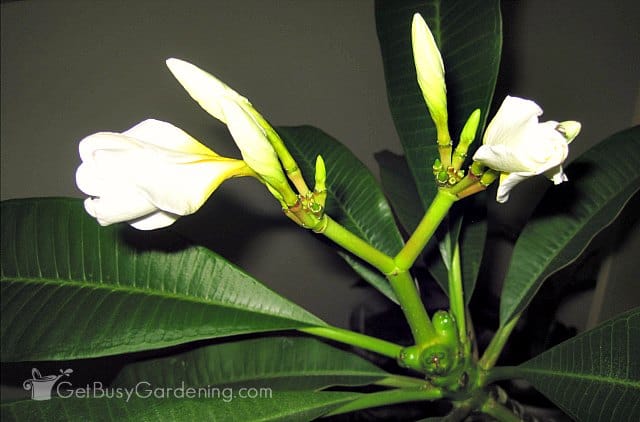
Watering Requirements
Plumerias like a lot of water, but won’t tolerate being overwatered. When they’re too wet, the trunk will rot, and it will eventually kill the plant.
It’s kind of a funny combination, give it a lot of water… but don’t overwater? I know, but don’t worry it’s actually pretty easy. A moisture gauge will help you get it right.
During the summer months, give it a really good, deep drink. Allow the excess to drain completely, and wait until it’s mostly dry before adding more.
Since they go dormant during the winter, it’s best to water them very sparingly, if at all, during those months.
Humidity
You might be surprised to learn that plumeria plants prefer moderate to low humidity levels.
If it’s extremely dry in your home, you can place a humidifier next to it to help add extra moisture to the air.
However, be careful misting or spraying them with water, you don’t want to overdo it. If droplets are constantly sitting on the branches or leaves, it could cause them to rot.
Light Requirements
Plumerias need full sun in order to grow their best and also to bloom, otherwise they will become sparse and leggy.
If yours is outside, put it in a full sun location. Otherwise if it’s indoors year round, then you’ll likely need to get a grow light.
When you move it outside for the summer, don’t give it full exposure right away, or it could burn. Instead, put it in the shade for a few days, and gradually introduce it to a full sun location.
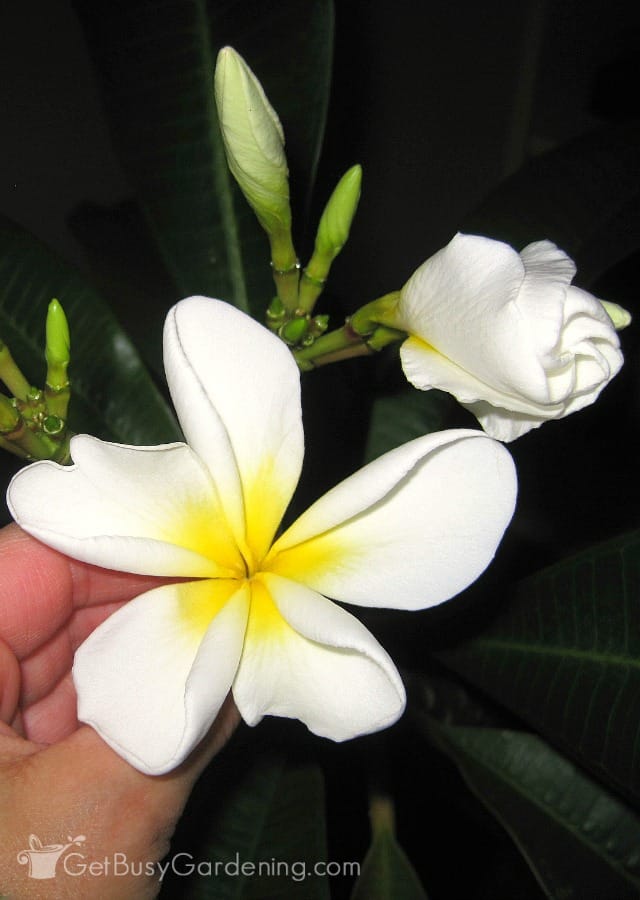
Temperature
Plumerias are not cold hardy plants. Their ideal temperature range is between 60-75°F.
If it gets much colder, they’ll start dropping their leaves, and below freezing temps will quickly kill them. Even a light frost can damage the tender branch tips.
Hotter weather doesn’t often bother them, though the high heat in arid climates will dry them out too quickly.
Best Soil
The best soil for successful plumeria plant care is a fast draining mix that’s slightly acidic, ranging between 6-7 on a pH meter.
You don’t necessarily need to buy any special type, and you can even make your own if you want.
I grow mine in a homemade mixture of 2 parts general purpose soil with 1 part each of either perlite or pumice, and sand.
Find out more about how to choose the best soil for your plumeria, including my recipe to make your own in my detailed guide.
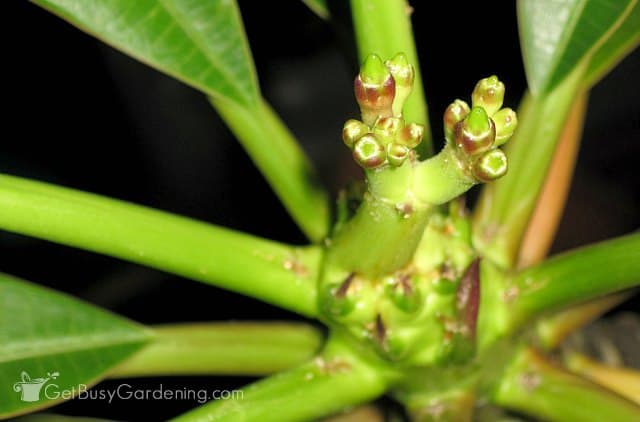
Fertilizer
As I already mentioned, plumerias are very heavy feeders, and fertilizing is an important part of their care.
They need a type that is high in phosphorus in order to bloom. Apply an organic liquid flower food every 1-3 weeks in the spring and summer. You can also apply granules monthly to provide even more nutrients.
Fertilize them from spring through summer, and stop in early fall. Then don’t feed them at all during the winter.
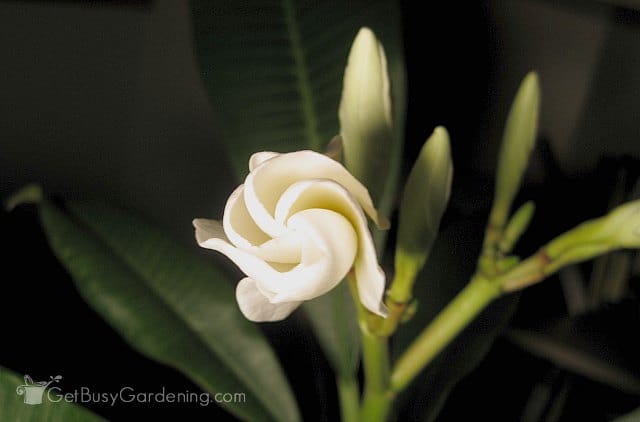
Repotting
With the proper care, frangipani trees can grow very rapidly, and may need repotting every 1-2 years.
When roots begin to come out of the drainage holes, or growth slows, it’s a sign they need to be sized up.
In the spring, move them into a container 2-4” larger than the current one. Replant it at the same depth, and expect some leaf drop or drooping as they recover.
If you want to limit their size, simply refresh the top few inches of soil and trim away some of the roots.
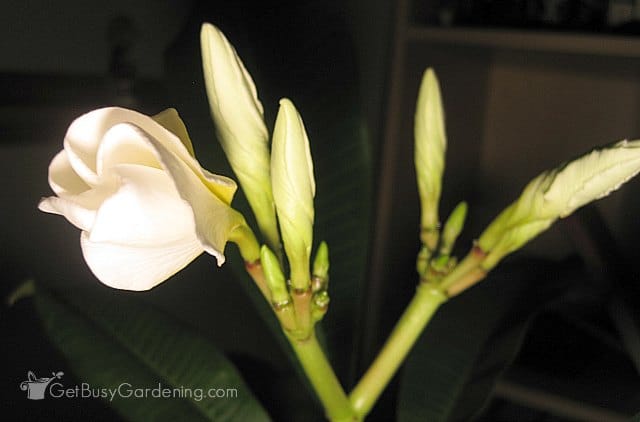
Tips For Controlling Plumeria Pests
Though pests aren’t usually an issue outdoors, plumerias can have problems with spider mites and whiteflies indoors.
If yours gets attacked by bugs, begin treating it right away. I recommend using neem oil, which is a natural pesticide that works great.
Organic insecticidal soap is also a good option. I sometimes make my own by mixing 1 tsp mild liquid soap per 1 liter of water.
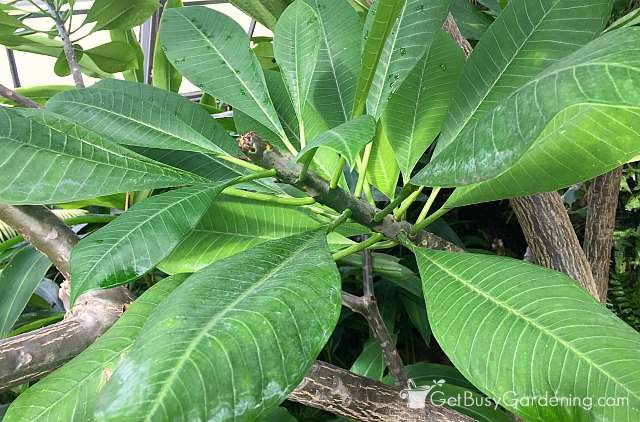
Pruning
Plumeria plants benefit from regular pruning as a part of their care routine. They can handle being trimmed back pretty severely, but never cut them all the way down to the ground.
The best time to do it is in the spring, or right after they’re done blooming.
Use sterile and sharp pruning shears so you get a nice clean cut. For thicker branches, you may need to use a lopper. Also, wear eye protection and gloves to protect against the sap.
Always make your cuts at a downward angle, so water can’t settle into the wound and cause the branch to rot.
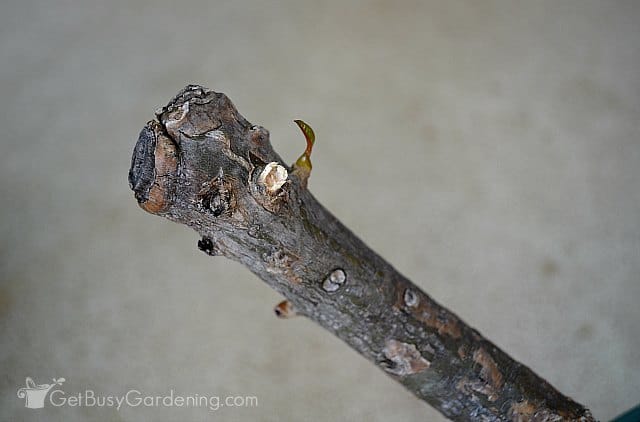
Plumeria Propagation Tips
Though they can be grown from seed, most home gardeners propagate their plumeria by taking cuttings.
It’s pretty easy to do. Simply take a section from a healthy branch, remove the flowers and leaves, and allow it to cure for several days.
Dip the cut end in rooting hormone, then place it into a slightly moist medium. Keep it in a warm spot until you see new growth on top. Get my step-by-step tutorial for how to propagate the cuttings here.
Plumeria Winter Care & Dormancy
Once the temperature starts to cool in the fall, and there’s less sunlight, your plumeria will start to go dormant naturally. This is the time to stop fertilizing, and slow down on watering.
The leaves will turn yellow and then brown before finally dropping off. This is totally normal, so don’t panic. It might not drop all of the leaves though, and that’s ok too.
If you live in a cold climate, this makes is much easier to overwinter them indoors. So there’s no need for artificial lights or a sunny window.
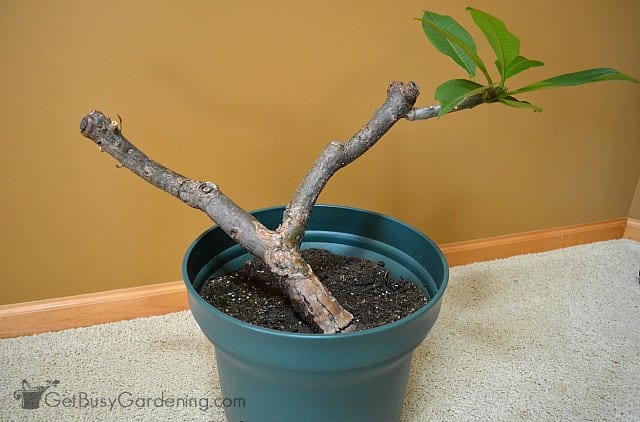
Troubleshooting Common Plumeria Care Problems
Though plumeria are fairly simple to care for, they are notorious for having a few problems. Below I’ll help you troubleshoot and fix the most common issues.
Tip Rot
In my experience, tip rot is a pretty common problem. It happens when water settles in a crack or wound on the end of a branch, which is usually caused by improper pruning or frost damage.
If left untreated, the rot will spread, and could eventually kill the plant. You can save it by cutting off all of the rotted pieces of the affected branch.
Stem Rot
If the stem is mushy and rotting at the base, then you have a more serious problem. Stem rot is caused by overwatering.
If left untreated, your plant will die for sure. If the rot isn’t too severe, you can save it by taking cuttings of the healthy stems or branches and rooting them.
Plumeria Won’t Bloom
This is probably the #1 question I get asked about growing plumerias, and there is one simple answer… fertilizer.
They need fertilizer in order to bloom, and lots of it. The good news is that it’s such an easy fix. Once you get the hang of it, they will flower profusely for you.
Leaves Falling Off / Dropping
Leaf drop can be caused by a lack of water or cold temperatures. It’s natural for them to go dormant during the winter when it gets below 50°F, and this is nothing to worry about.
However, if it happens during the summer, then check to make sure they’re getting enough water. They should never dry out completely. Also inspect the branches and trunk for signs of rot.
Leaves Turning Yellow
Yellow leaves are also a sign that they’re starting to go dormant, however it could be from overwatering, pests, or disease.
Check the soil to make sure it’s not wet or soggy, inspect the leaves for bugs, and verify that the stems are firm and not rotting.
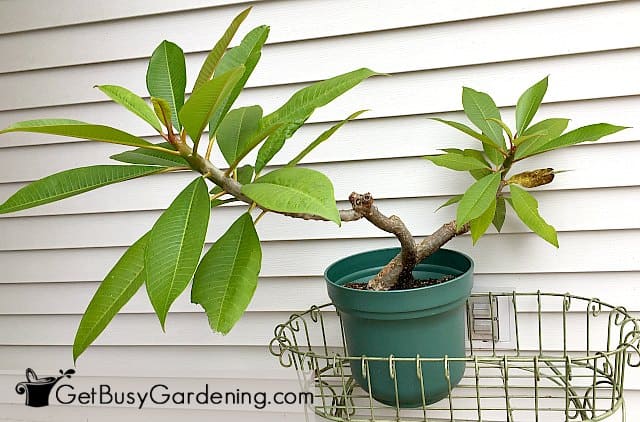
FAQs
In this section I’ve answered some of the most frequently asked questions about plumeria care. If yours isn’t listed, please ask in the comments below.
Are plumeria hard to care for?
No, plumeria are not hard to care for. They’re actually quite easy to grow, as long as you understand their requirements.
How long does it take for a plumeria to be full grown?
How long it takes for a plumeria to be full grown totally depends on the variety. Some grow must faster than others, though on average they can put on 12-36″ per year with the proper care.
Is plumeria an indoor or outdoor plant?
Plumeria can be either an indoor or outdoor plant, depending on where you live. They’re only hardy in the warmest regions, so people in cold climates must bring them indoors during winter.
Is plumeria a succulent?
No, technically plumeria is not a succulent, they are tropical plants. Though they do have some similar care requirements and properties.
Is frangipani the same as plumeria?
Yes, frangipani is the same plant as plumeria. Frangipani is the common name for them. Plumeria is technically the scientific name, though many people also call them that since it’s easier to pronounce.
Plumerias are wonderful plants that are surprisingly easy to care for. Once you know the tricks for growing them, you’ll be able to keep yours thriving for decades to come.
If you want to learn all there is to know about maintaining healthy indoor plants, then you need my Houseplant Care eBook. It will show you everything you need to know about how to keep every plant in your home thriving. Download your copy now!
More Houseplant Care Guides
- How To Grow Begonia Plants
- Wandering Jew Plant Care & Growing Guide
- African Milk Tree: How To Grow & Care For A Euphorbia trigona Plant
Share your plumeria plant care and growing tips in the comments section below.


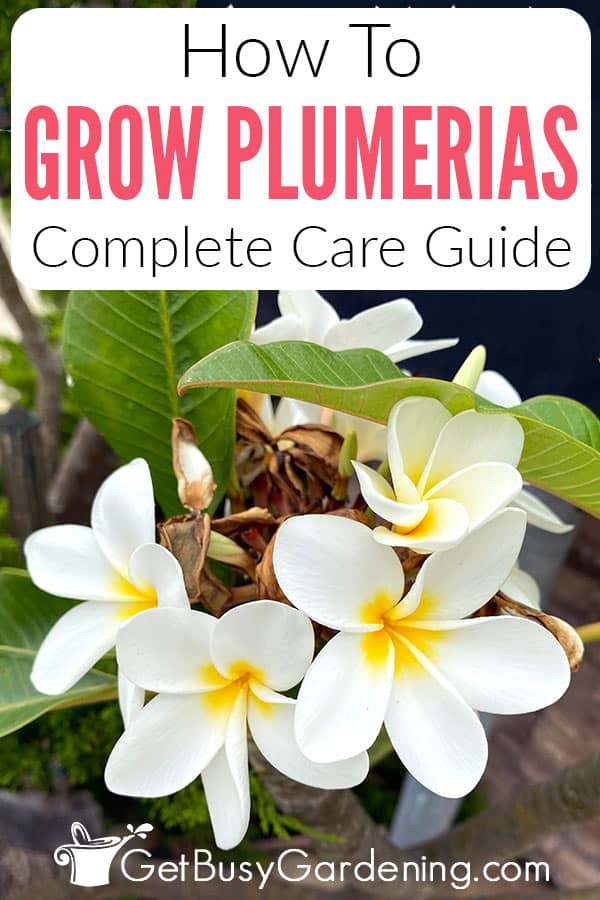
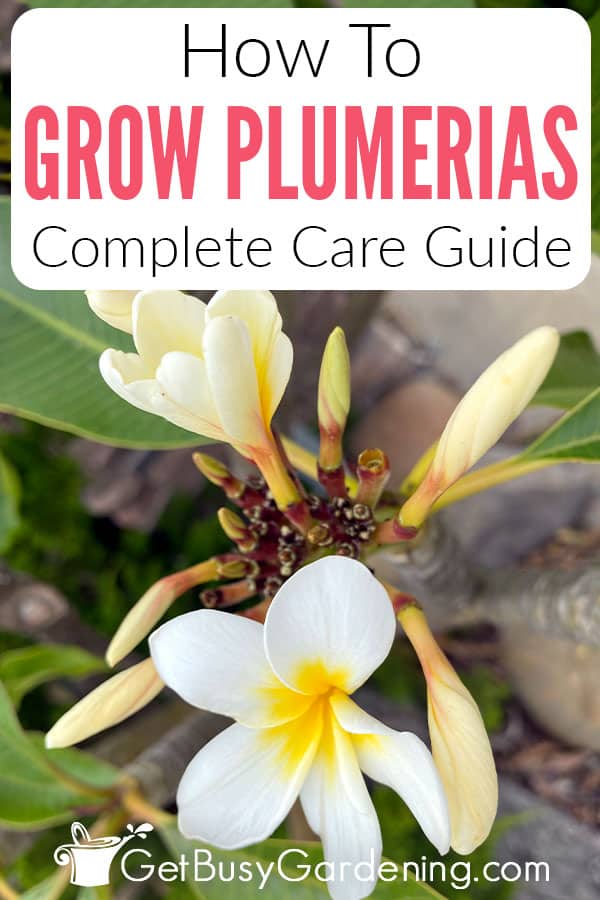
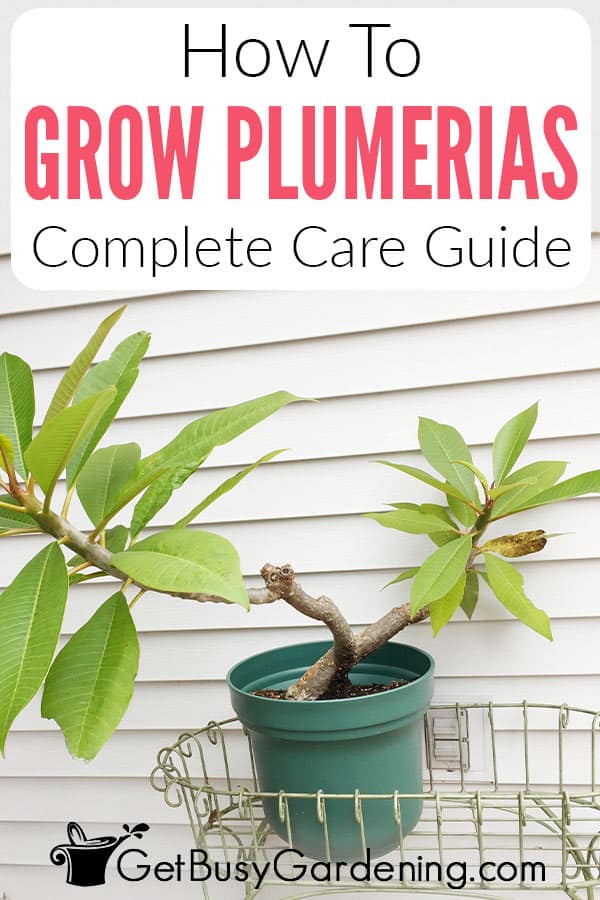
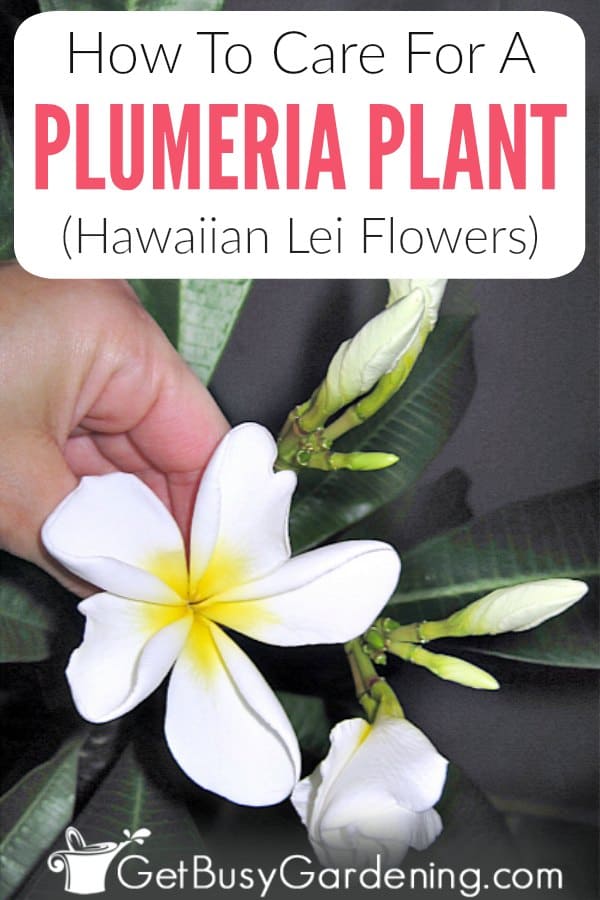



Sheila says
I have had my plumeria for 4 years. It I growing and I get huge leaves, but not flowers. My house doesn’t get much sunlight and my yard get shady quick and windy so I have been leery of putting it outside . I have just started fertilizing. What are your recommendations concerning sun light? I was considering some sort of light. I have had no problems with pests so far . Not sure if a light would cause this problem . I live in Bonners Ferry, Idaho.
Amy Andrychowicz says
Put your plumeria in a south facing window where it will get full sun all day long. If it starts to grow leggy or reaching for the window, then you can add a grow light. The grow light won’t cause any pest issues. Move it to a dark room sometime in the fall, and let it go dormant during the winter.
Leslie says
Hi Amy,
My plant just has blooms now and are miniature flowers for some reason and have no fragrance. ? have you heard of this?
Amy Andrychowicz says
It could just be the type of plumeria plant you’re growing. Some are more fragrant than others.
Kathy says
I have a plumeria that came as a single stock last year. It has grown wildly and is actually blooming right now but it has never branched. If I leave it alone as it grows will it branch or do I need to prune it to encourage branching. It’s happy and healthy so I don’t want to mess with it unless I need to.
Amy Andrychowicz says
You’ll need to prune your plumeria in order to get it to branch out. Otherwise, it will just continue to grow taller.
Luna says
Hi,
I’m wondering if anybody can tell me how long it usually takes for a frangipani to bloom once it started to form buds (like in the fourth picture from above).
Thank you!
Amy Andrychowicz says
It can take a few weeks for those tiny plumeria buds to open. Exact timing depends on the light and environment it’s living in.
Luna says
Thank you Amy! It just started and we have a vacation coming up in seven weeks…. It’s the first time we got this far, I’m in germany…
Trish Reed says
For anyone needing a good, reputable place to buy plumerias, Durhambotanicals.com is AWESOME! I always get large, healthy, multi tip plants from Chris Durham. I won’t buy anywhere else unless he doesn’t have what I want. He also sells a few other types of plants.
Amy Andrychowicz says
Awesome, thanks for the recommendation for where to buy plumerias.
Sandy says
Has anyone ever been bothered with ants crawling all over the leaves of your plumeria plants?
Amy Andrychowicz says
No, I have never had that problem. Check your plumeria for aphids. Sometimes ants crawling on a plant can be a sign of an aphid infestation.
Jackie M West says
Hi Amy great site. I was given a single stem plumeria in a small 6” clay pot over the winter I had no idea what it was, my daughter filled me in. She has a friend that has one. The stem is about 14” long, it had no leaves so I put it with the rest of my inside plants and pretty much forgot about it (I got lucky) when I saw the new leaves at the tip I moved it to my porch and began watering it and the leaves are coming on pretty strong. I’m so excited. My question is this. There are some baby plants growing in the pot. They are very leggie 6” or more with two sets of leaves at the top. Is it possible that these are babies. I really don’t want to do the wrong thing. Should I put them in a different pot or leave them for a bit. I’m hoping for babies but if not I don’t want them to drain resources from my new lovely. Looking forward to your help. Many thanks for all the great tips.
Amy Andrychowicz says
If the plants growing around the bottom look like your main plumeria plant, then I would guess they are babies. However, plumerias don’t grow babies from the base of the plant. So if they are plumeria babies, then the person you got the plant from must have rooted cuttings and then planted them in the pot with the mother plant. You could certainly pot them up into their own containers if you want. I don’t think it would be bad to leave them be until they get a bit larger. It sounds like they’re not doing well, so they might not like to be repotted until they grow stronger.
Darlene says
I’m real new to this. I just got my plant from the nursery and started reading up on how to care for it. It’s a mini white and it’s in May and I live inTampa Fl. I plan to keep it outside. Should I report it now and get it out of the black nursery pot due to the heat here? It looks like it’s in a 2 qt container. Should I go bigger? It has 3 stems . No blooms yet. What do I do about rain since it will be in a pot? If we get a lot should I take it in?
Amy Andrychowicz says
If the plumeria plant is well established in the nursery pot, or it’s root-bound, then yes, I would repot it into a larger container. Just make sure that the container you choose has drainage holes in the bottom. Also, if you’re concerned about your plumeria getting too much water when it rains, then be sure to use a fast draining soil when you repot it. See the section above titled “Best Soil For Plumeria Plant” for my soil recommendations.
Mitch W Roberts says
Amy I was given one while we were in Florida and we live in Tennessee. So I wasn’t sure how to take care of it till I started to research the Internet an came across your web site. My passion is Angel Trumpets and after I read info on how to take care of my new to me plant I don’t think I’ll have any problems with taking care of it. Thank You for info.
Amy Andrychowicz says
You’re welcome! I hope your brand new plumeria plant will thrive and bloom for you for many years to come. 🙂
Joan Jones-Borgman says
Hi Amy. My question is how often do I need to transplant my plumeria trees? I bought one at the botanical garden somewhere in Florida AND my BFF broke me a tri-branch off her tree just for fun they are now 3 years old and getting rather large. I love them big but when do I move them into their permanent pots? I started them in 1.5 gallon nursery pots how big should I go? I loved your information!
Amy Andrychowicz says
You don’t need to repot plumerias very often, they will grow fine in the same pot for years. However, if it doesn’t bloom or is completely pot-bound, then I would repot it into a larger container. It’s usually best to go up one pot size at a time when repotting plants, rather than using a huge pot. The best time to repot plumerias is in the spring. But, if you don’t want to wait that long, then you can repot yours during the summer. Just don’t repot it in the fall before dormancy.
Joan Jones Borgman says
I am so happy with the performance of my plumeria. My only concern/complaint is that the blooms did not have much fragrance. Is there something I can do now through next spring to enhance the fragrance next bloom season?
Amy Andrychowicz says
Great to hear that your plumeria is performing so well for you! I don’t think there’s anything you can do to make the plumeria flowers more fragrant. It’s probably just the variety of plant that you have, some are more fragrant than others.
Alex says
I have a afrique plumeria and the flower bud that sticks from the top of the plumeria and is connected to the stem is turning brown. I gave it a little push and it came off. But it’s still June and idk what to do after it falls off.
Amy Andrychowicz says
You don’t need to do anything special to your plumeria after the bloom spikes fall off.
Juanita Gibbs says
I have a plumria ith 2stems one has leaves the other 3 1inch leaves sinch feb. not growing what could be the reason
Som one said i should cut it. I also found wounds on stem where my husbnd scrape in pulling them out the garage it looks bad i put cinnimon on them should i cut it please reply.
Amy Andrychowicz says
I would check the stems to make sure they aren’t rotting. If all the stems are firm and healthy, then your plumeria is probably just slow to come out of dormancy. You could repot it into fresh potting soil to see if that triggers new growth. Or you could try giving it a weak dose of liquid fertilizer to see if that helps.
Juanita Gidds says
Hi Amy thanks for your information plumeries are.doing fine.I fell in Febuary2019 fracture in my back and 2 torn rotator cups i have had five back surgerys i also have fusion and a rod so mu husband has been watering my plumeries i am just starting to understand the i pad.i was looking at my plumeries leaves drooping turning yellow so ventured outside today stuck my finger in soil it was so dry. My plumersare large in 18inch pots not been able to care for them as i usually do only two have bloomed.l have been reeding all your advice to subscribers you are great my fellow gardener .l always enjoy educational advice from someone who knowes what they are talking you made my day dear. I was a master gardener i am now75 years young and still learning you arenever to old to learn thanks keep giving your knoledge to us love it and thankful
Amy Andrychowicz says
Yikes, sorry to hear about your back! Glad you’re up and moving again, get well soon. Thanks for your nice comments, they made my day! Never stop learning. 😉
Ken says
Hi Amy, I have 2 plumeria that I started from cuttings given to me last summer, I stuck them in pots outdoors useing some sandy soil from my yard just to get them going. One plant didn’t do anything all summer the other got about 6 leaves. I live in MI so in late Sept. I brought them inside, repotted them with a soil mix for succulents, gave them a grow light, and started watering 1X a week and fertilizing every other week. The one that had leaves took off, developed 20+ leaves and gained at least 12 inches since then, It is now the end of April and it has been loosing leaves rather rapidly (6 to 8) in the last few weeks. first they droop, turn yellowish, and fall off dry and kinda shrivled. Could it be that it is confused and trying to go domant now? how do I know, the indoor temperature has been fairly consistent and it is still developing new leaves. The leaves are clean, I see no signs of bugs. What about lack of light? the upper leaves block light from back side and lower leaves. Or could it be rootbound already? the pot is 9″ wide w/ 7″of soil deep. Thanks for your help! The other plant eventually began to grow and is doing well.
Amy Andrychowicz says
I am a little worried about the fact that you said you’re watering them once a week. Overwatering plumerias can cause root and stem rot, which would definitely cause them to drop their leaves. I would check the entire length of the stem to make sure none of it is mushy or rotting.
Ashley says
My Plumeria has what I now think is tip rot, as all 3 tips on one of my plants are raisin looking and squishy. New leaves have started growing about 3″ below the squishy parts and look really healthy. Should I cut the squishy parts off?
Amy Andrychowicz says
Yes, you definitely want to cut all of the tip rot off of your plumeria right away. If not removed, the rot can spread and end up killing the entire plant. Here’s a post I wrote about how to save a cactus from tip rot, but you can follow those same steps to save your plumeria. I recommend making downward cuts on your plumeria though, rather than cuts that face upward. Upward facing cuts are spots where water can pool, and cause more tip rot in the future. Good luck!
Sandra Merwin says
I have an issue with 3 of my plumeria rootings from last April. The finger has rot and a couple have fallen off. I also have stem rot in one of the plants. I just put fungicide on them. Do I cut the rot off the fingers? What do I do with the stem rot that is very soft and mushy? Thanks
Amy Andrychowicz says
Sorry to hear your plumeria has stem and tip rot. Yes, you definitely need to cut off all of the rot. Fungicide won’t do anything, and the rot will continue to spread if any is left on the plant. Here’s a post that I wrote about saving a cactus from tip rot, but the same tips apply to saving a plumeria from tip rot. As for the stem rot… it depends on where it is on the stem. If it’s high up and just under the branches, then you may need to cut the entire top off to get all the rot. If the stem rot is at the bottom of the stem, then your only option will be to cut the stem above the rot, and propagate the plumeria cutting. Good luck!
Lois says
Appreciate your information. I live in Austin, TX and have mine in pots, is it possible to keep it small and still flower without getting too tall? I have had blooms through the winter and new flowers are still coming in 1 gallon pots. I want to keep them as house plants since its too windy and hot and enjoy the smells indoors :-).
Thanks,
Amy Andrychowicz says
Yes, you can prune plumerias to keep them small. The best time for pruning plumerias is late winter or early spring, or right after they’re done blooming. Read the “How To Prune Plumeria Plants” section above for more information.